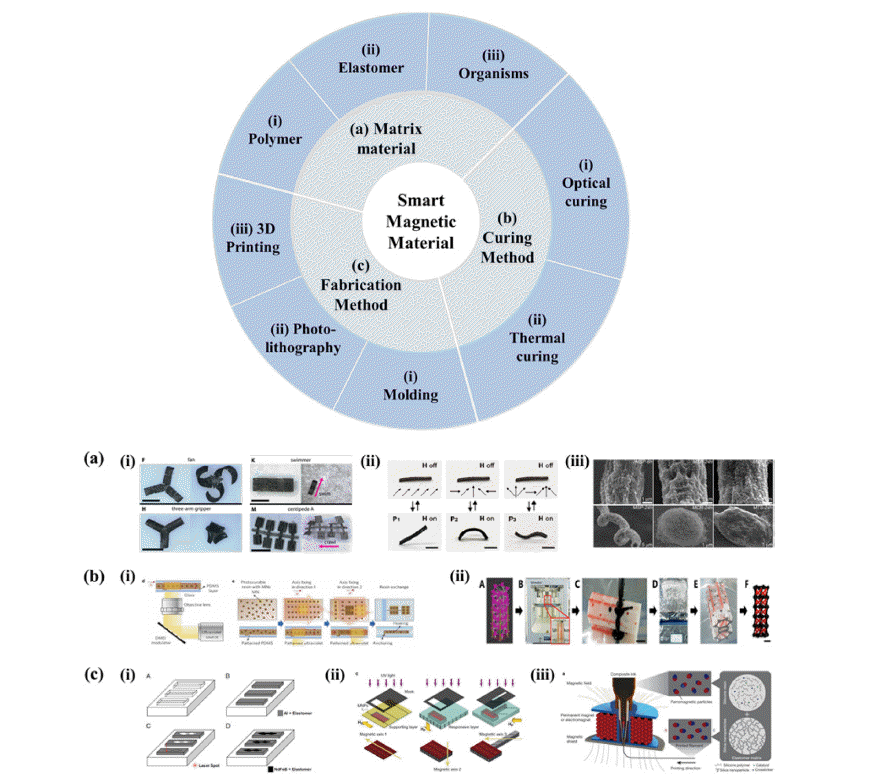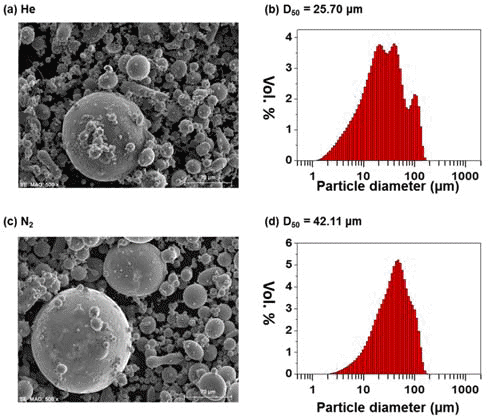Search
- Page Path
- HOME > Search
- [Korean]
- Recent Advances in Soft Magnetic Actuators and Sensors using Magnetic Particles
- Hyeonseo Song, Hajun Lee, Junghyo Kim, Jiyun Kim
- J Korean Powder Metall Inst. 2021;28(6):509-517. Published online December 1, 2021
- DOI: https://doi.org/10.4150/KPMI.2021.28.6.509

- 616 View
- 2 Download
- 1 Citations
-
 Abstract
Abstract
 PDF
PDF Smart materials capable of changing their characteristics in response to stimuli such as light, heat, pH, and electric and magnetic fields are promising for application to flexible electronics, soft robotics, and biomedicine. Compared with conventional rigid materials, these materials are typically composed of soft materials that improve the biocompatibility and allow for large and dynamic deformations in response to external environmental stimuli. Among them, smart magnetic materials are attracting immense attention owing to their fast response, remote actuation, and wide penetration range under various conditions. In this review, we report the material design and fabrication of smart magnetic materials. Furthermore, we focus on recent advances in their typical applications, namely, soft magnetic actuators, sensors for self-assembly, object manipulation, shape transformation, multimodal robot actuation, and tactile sensing.
-
Citations
Citations to this article as recorded by- Advanced Magnetic Actuation: Harnessing the Dynamics of Sm2Fe17–xCuxN3 Composites
Kangmo Koo, Young-Tae Kwon, Ji Young Park, Yong-Ho Choa
ACS Applied Materials & Interfaces.2024; 16(9): 11872. CrossRef
- Advanced Magnetic Actuation: Harnessing the Dynamics of Sm2Fe17–xCuxN3 Composites
- [Korean]
- A Study on the Microstructure and Magnetic Properties of Fe83.2Si5.33-0.33
x B10.67-0.67x Px Cu0.8 Nanocrystalline Soft Magnetic Alloys with varying P Content - Hyun Ah Im, Kyoung-Hoon Bae, Yeong gyun Nam, Subong An, Sangsun Yang, Yong-Jin Kim, Jung Woo Lee, Jae Won Jeong
- J Korean Powder Metall Inst. 2021;28(4):293-300. Published online August 1, 2021
- DOI: https://doi.org/10.4150/KPMI.2021.28.4.293

- 640 View
- 8 Download
-
 Abstract
Abstract
 PDF
PDF We investigate the effect of phosphorous content on the microstructure and magnetic properties of Fe83.2Si5.33-0.33
x B10.67-0.67x Px Cu0.8 (x = 1–4 at.%) nanocrystalline soft magnetic alloys. The simultaneous addition of Cu and P to nanocrystalline alloys reportedly decreases the nanocrystalline size significantly, to 10–20 nm. In the P-containing nanocrystalline alloy, P atoms are distributed in an amorphous residual matrix, which suppresses grain growth, increases permeability, and decreases coercivity. In this study, nanocrystalline ribbons with a composition of Fe83.2Si5.33-0.33x B10.67- 0.67x Px Cu0.8 (x = 1–4 at.%) are fabricated by rapid quenching melt-spinning and thermal annealing. It is demonstrated that the addition of a small amount of P to the alloy improves the glass-forming ability and increases the resistance to undesirable Fex(B,P) crystallization. Among the alloys investigated in this work, an Fe83.2Si5B10P1Cu0.8 nanocrystalline ribbon annealed at 460°C exhibits excellent soft-magnetic properties including low coercivity, low core loss, and high saturation magnetization. The uniform nanocrystallization of the Fe83.2Si5B10P1Cu0.8 alloy is confirmed by high-resolution transmission electron microscopy analysis.
- [Korean]
- Development of Hybrid Insulating Coating for Fe-based Soft Magnetic Powder
- Jungjoon Kim, Sungyeom Kim, Youngkyun Kim, Taesuk Jang, Hwi-jun Kim, Youngjin Kim, Hyunjoo Choi
- J Korean Powder Metall Inst. 2021;28(3):233-238. Published online June 1, 2021
- DOI: https://doi.org/10.4150/KPMI.2021.28.3.233

- 447 View
- 6 Download
-
 Abstract
Abstract
 PDF
PDF Iron-based amorphous powder attracts increasing attention because of its excellent soft magnetic properties and low iron loss at high frequencies. The development of an insulating layer on the surface of the amorphous soft magnetic powder is important for minimizing the eddy current loss and enhancing the energy efficiency of highfrequency devices by further increasing the electrical resistivity of the cores. In this study, a hybrid insulating coating layer is investigated to compensate for the limitations of monolithic organic or inorganic coating layers. Fe2O3 nanoparticles are added to the flexible silicon-based epoxy layer to prevent magnetic dilution; in addition TiO2 nanoparticles are added to enhance the mechanical durability of the coating layer. In the hybrid coating layer with optimal composition, the decrease in magnetic permeability and saturation magnetization is suppressed.
- [Korean]
- Investigation on Fe-Hf-B-Nb-P-C Soft Magnetic Powders Prepared by High-Pressure Gas Atomization
- Jae Won Jeong, Dong-Yeol Yang, Ki Bong Kim, Junhong Lee, Young Ja Kim, Tae-Soo Lim, Sangsun Yang, Min Ha Lee, Hwi Jun Kim, Yong-Jin Kim
- J Korean Powder Metall Inst. 2016;23(5):391-396. Published online October 1, 2016
- DOI: https://doi.org/10.4150/KPMI.2016.23.5.391

- 530 View
- 1 Download
- 3 Citations
-
 Abstract
Abstract
 PDF
PDF In this study, ultra-fine soft-magnetic micro-powders are prepared by high-pressure gas atomization of an Fe-based alloy, Fe-Hf-B-Nb-P-C. Spherical powders are successfully obtained by disintegration of the alloy melts under high-pressure He or N2 gas. The mean particle diameter of the obtained powders is 25.7 μm and 42.1 μm for He and N2 gas, respectively. Their crystallographic structure is confirmed to be amorphous throughout the interior when the particle diameter is less than 45 μm. The prepared powders show excellent soft magnetic properties with a saturation magnetization of 164.5 emu/g and a coercivity of 9.0 Oe. Finally, a toroidal core is fabricated for measuring the magnetic permeability, and a μr of up to 78.5 is obtained. It is strongly believed that soft magnetic powders prepared by gas atomization will be beneficial in the fabrication of high-performance devices, including inductors and motors.
-
Citations
Citations to this article as recorded by- Optimization of Densification Behavior of a Soft Magnetic Powder by Discrete Element Method and Machine Learning
Jungjoon Kim, Dongchan Min, Suwon Park, Junhyub Jeon, Seok-Jae Lee, Youngkyun Kim, Hwi-Jun Kim, Youngjin Kim, Hyunjoo Choi
MATERIALS TRANSACTIONS.2022; 63(10): 1304. CrossRef - Optimizing the magnetic properties of Fe-based amorphous powder by adjusting atomic structures from vitrification at different temperatures
Song-Yi Kim, Hye-Ryeong Oh, Hyeon-Ah Kim, A-Young Lee, Hwi-Jun Kim, Sang-Sun Yang, Yong-Jin Kim, Hyun-Joo Choi, Il-Hyun Kim, Hyun-Gil Kim, Jürgen Eckert, Jong-Ryoul Kim, Min-Ha Lee
Journal of Applied Physics.2019;[Epub] CrossRef - Soft magnetic properties of Fe-based amorphous/nanocrystalline hybrid materials
Yeonjoo Lee, Jonggyu Jeon, Seungjin Nam, Teasuk Jang, Hwijun Kim, Minwoo Lee, Yongjin Kim, Dongyeol Yang, Kyeongsik Min, Hyunjoo Choi
Powder Technology.2018; 339: 440. CrossRef
- Optimization of Densification Behavior of a Soft Magnetic Powder by Discrete Element Method and Machine Learning
TOP
 kpmi
kpmi


 First
First Prev
Prev


